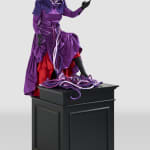-
Mary Sibande South Africa, b. 1982
Ascension of the Purple Figure, 2016Fiberglass, resin, fabric, and steel on painted wood plinth111 3/4 x 39 3/4 x 39 3/4 in
284 x 101 x 101 cm7454Copyright Mary Sibande, 2016Further images
In this work, we see Sophie, Mary Sibande's avatar, stepping up onto a pedestal. She is in her purple phase, representative of the spirit of constructive resistance encapsulated by the...In this work, we see Sophie, Mary Sibande's avatar, stepping up onto a pedestal. She is in her purple phase, representative of the spirit of constructive resistance encapsulated by the Purple Rain protests in South Africa, during which authorities sprayed protestors with purple ink from water cannons, intent on marking them so they could be arrested later. Purple is also a vague reference to clergy, and royalty, two authoritarian forces in colonial Africa, but also two two roles that would never have been afforded Sophie in times past. Here, she is adorned in her purple garb, ascending with dignity into her new role. Beneath her purple clothing, we can already see hints of her next phase: the red phase.
Color is a fundamental aspect of Sibande's practice. She was born Black in Johannesburg, South Africa, in 1982— part of the majority, yet oppressed by the institutionally white supremacist Apartheid system, which granted minority whites supreme political control. Sibande’s mother was a domestic worker—her uniform a standard, blue dress with white, lace apron and headscarf. Her father, dressed in green fatigues, served in the South African Army. When she was just seven years old, Sibande watched as the police turned water cannons filled with purple dye onto anti-apartheid protestors days before national elections. The purple dye was intended to make protesters easier to arrest, and indeed hundreds were rounded up and jailed, yet protestors commandeered one of the cannons and turned it on the governing party’s legislative offices. After the riot, graffiti around the city foretold, “The purple shall govern.” Six years later, Apartheid would officially end, but still today racial inequity is rampant in South Africa. Sibande expresses the frustration of contemporary Black South Africans with the color red, a choice stemming from the Zulu aphorism, “ie ukwatile uphenduke inja ebomvu,” meaning “he is angry, he turned into a red dog.”
Sibande employs the human form as a vehicle through photography and sculpture as a focused critique on the stereotypical depictions of women, particularly black women in South Africa. The body, for Sibande, and particularly how we clothe it, is the site where this history is contested and where Sibande’s own fantasies can play out. This counter history takes the form of an alter-ego in Sibande’s early work, a persona by the name of ‘Sophie’ who is dressed in various uniforms that resemble the dresses worn by domestic workers. Altering these dress styles into Victorian motifs, Sibande completely reanimates Sophie’s history through how her body is adorned and the way she occupies these narratives that were stolen and denied from her. Transitioning from blue to green to purple to red, Sibande introduces us not only to the many faces of herself and ‘Sophie’, but to the complex person hoods of African Women who continue to create worlds and narratives outside of the canon of Western Imperialism.Provenance
Artist's Studio
Kavi Gupta | Chicago
Exhibitions
Mary Sibande - Unhand me, Demon!, 2021. Kavi Gupta | Elizabeth St, Chicago, IL;













